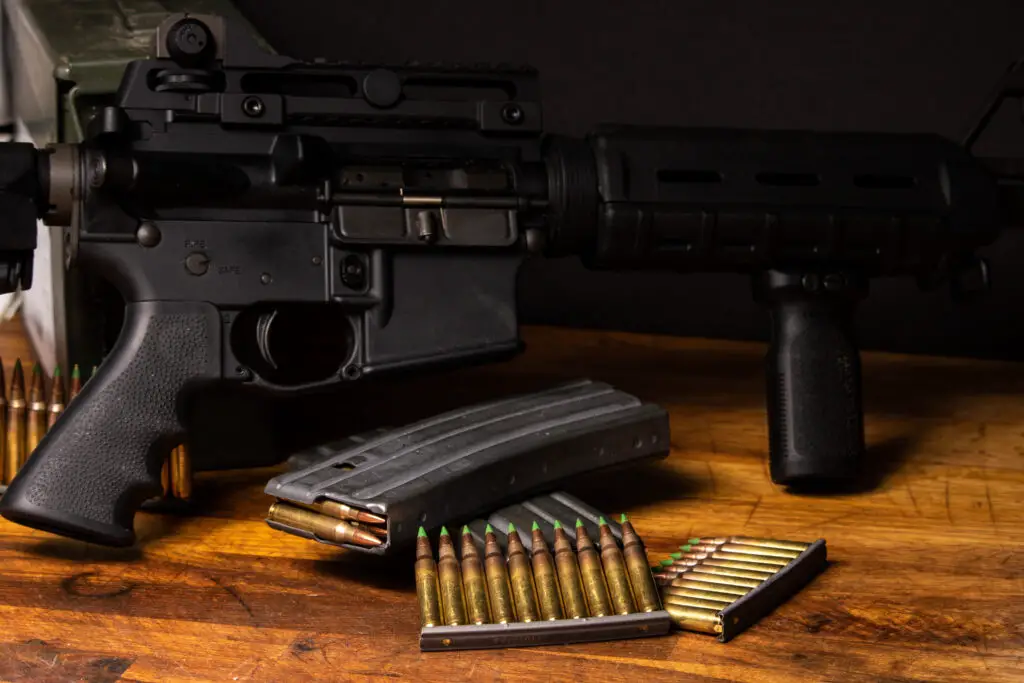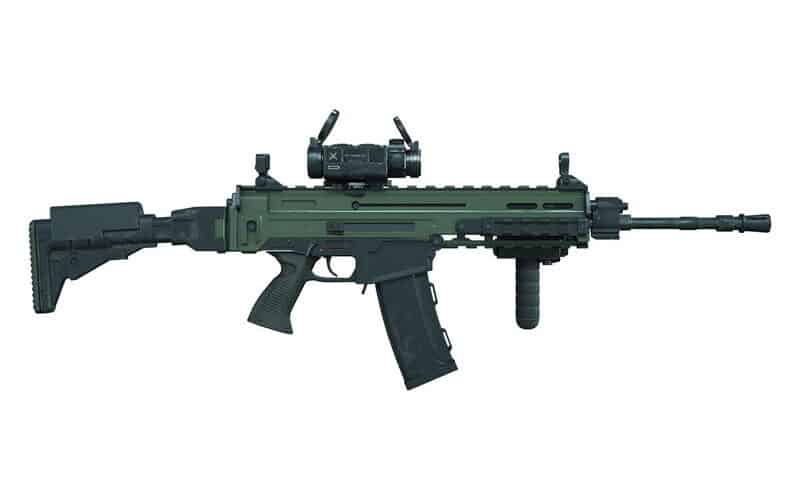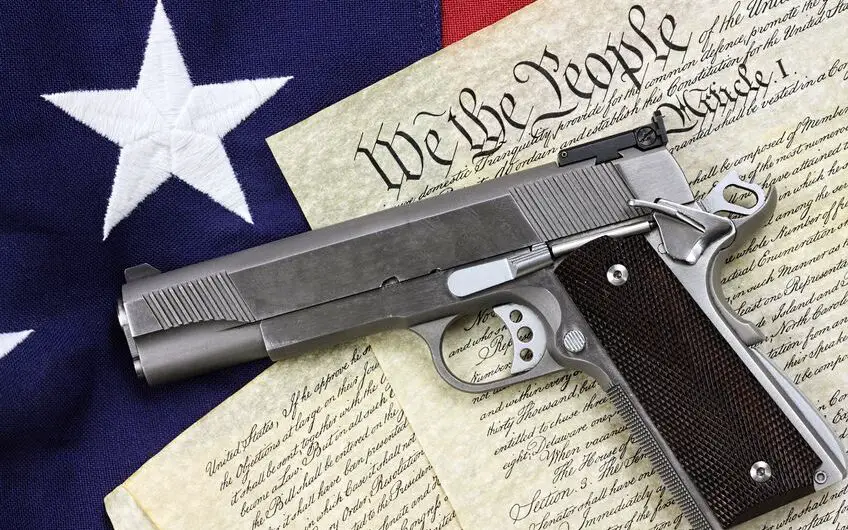
There are so many different types of guns out there, from rifles to shotguns to handguns, and many more. And for many guns, there are even smaller subcategories within those larger ones. So when it comes to an automatic rifle and assault rifle, what is the true difference between the two?
The main difference between an automatic rifle and an assault rifle is that an automatic weapon can be capable of either semi-automatic, fully automatic fire, or both, while an “assault rifle” is actually a misnomer, misapplied to many automatic firearms because of its appearance, not its use.
In this article, we will go through some different things about these rifles, including the differences between semi-automatic and fully automatic rifles, and the history behind the term “assault rifle.”
What is an Automatic Rifle?
To start, we need to give a little more context to the definition of an automatic rifle. The basic definition of an automatic weapon is a firearm that loads another round of ammunition mechanically after the previous round has been fired and is capable of fully automatic fire.
With the definition of an automatic weapon in mind, an automatic rifle is, simply put, a rifle capable of automatic fire.
Another definition is given by the NRA-ILA: “A firearm designed to feed cartridges, fire them, eject their empty cases and repeat this cycle as long as the trigger is depressed and cartridges remain in the feed system. Examples: machine guns, submachine guns, selective-fire rifles, including true assault rifles.” Source
In summary, holding down the trigger will continue to fire the firearm until the ammunition is depleted.
Automatic rifles are heavily regulated in the United States, and although it is possible to acquire one, it is quite difficult.
Two examples of this are:
- The NFA (National Firearms Act): This act, first introduced in 1934, “requires the registration, with the federal government, of fully-automatic firearms (termed “machine guns”), rifles and shotguns that have an overall length under 26 inches, rifles with a barrel under 16 inches, shotguns with a barrel under 18 inches, and firearm sound suppressors (termed “silencers”).”
- And the GCA (Gun Control Act) enacted in 1968, prohibited the importation of fully automatic rifles for private purposes. In 1986, an amendment to the Act also prohibited the domestic manufacture of fully automatics for private purposes. Source
State laws may vary greatly when it comes to the requirements needed to gain approval for buying and owning any kind of automatic rifle. They will also define whether there is a waiting period needed, what age the buyer needs to be, and if certain types of verification are needed.
What you have to do to own a fully automatic rifle: A fully automatic firearm purchase is much more complicated and involved, and it can take over a year to receive clearance to complete the process. You will need a special application, with fingerprint cards through your local law enforcement agency, and a detailed background check conducted by the FBI. Also, a $200 “Tax Stamp” is a required purchase that is part of the process. The dealer will hold onto the firearm until proper approval has been received.

Other NFA-restricted devices, like suppressors (often incorrectly called “silencers”), destructive devices, and machine guns will also require this same process. Any felons or violent criminals are prohibited from purchasing or owning firearms until their records have been cleared or expunged.
You cannot purchase a firearm at any type of gun show without any sort of background check. Any gun sales at gun shows, expos, and public events have the same regulations and restrictions as any federally licensed firearm dealer.
Some Examples Of Automatic Weapons
- Machine Gun – Defined as an “auto-firing, rifled long-barrel autoloading firearm designed for sustaining direct fire with fully powered cartridges.” Source Machine guns are mainly designed to be used by military infantry and usually attached to some sort of mount (like a bipod or tripod) to help stabilize it against a heavier recoil. One unique thing about machine guns is they can also use belt feeding, which is something not often found in other types of repeating firearms.
- Submachine Gun – The main differences between a machine and submachine gun are the size and the ammunition. While a machine gun is is longer, like a rifle, a submachine gun is smaller, more like a glorified handgun or pistol. And while a machine gun uses rifle ammunition, a submachine gun just uses handgun ammunition. Some submachine guns also have selectable firing modes.
- Gatling Gun – First invented in 1861 and used on the battlefields of the American Civil War, this gun is believed to be the first categorized as fully automatic.
- Machine Pistols – Machine pistols are pistols that can fire automatically, like the TEC-9. Machine pistols are also easily made from spare parts that can regularly be found at a Home Depot, though it is highly illegal to make one.
What is an Assault Rifle?
An assault rifle is a classification of weapon defined as any medium-caliber weapon that can select between semi-automatic, automatic, and/or three-shot burst modes.
The term assault rifle is said to have been first used by Hitler when he renamed the MP (Maschinenpistole) 43 improvement as the StG (Sturmgewehr) 44. Sturmgewehr translates to “assault rifle.” It has since then evolved into the classification used today.
The U.S. Army defines assault rifles as: “short, compact, selective-fire weapons that fire a cartridge intermediate in power between submachine gun and rifle cartridges.”
As mentioned above, assault rifles are capable of automatic firing, which by definition makes them automatic rifles. However, though an assault rifle is inherently an automatic rifle, an automatic rifle is not inherently an assault rifle. It’s similar to the differences between squares and rectangles: a square is inherently a rectangle, but a rectangle is not inherently a square.
While it is possible and legal to acquire and possess an assault rifle, depending on the state, according to the ATF it must have been manufactured before 1986. There are also some incredibly heavy fees and an extensive approval process with lots of paperwork involved. To acquire a selective-fire M16, for example, would run you approximately $30,200 and could take anywhere from 6 months to a couple of years to even get the license needed to legally own it.
Some Examples of Assault Rifles
- M4 – This assault rifle is the standard rifle used for most military units. It is defined as “a lightweight, gas operated, air cooled, magazine fed, selective rate, shoulder fired weapon with a collapsible stock” Source This Firearm has a short barrell with a collaspible stock that allows soldiers the capacity to work and operate in close quarters and with a capacity to accurately engage targets that are at a father range.
- M16 – This rifle is more commonly known as the AR-15, is “one of the longest continously-serving rifle in the United States” Source This rifle is air cooled and gas operated, which means that the components of this specific rifle can be reconfigured so that it can support different features. These specific weapons have high accuracy and reliability, but are not very good for dealing with larger groups of hostiles.
- AK-47 – The official name of this rifle is the Avtomat Kalashnikova. This rifle is a gas operated, asssault rifle that was developed by the Soviet Union. The rifle was finished in 1947, which is where the 47 in the name comes from. This rifle is one of the most popular rifles because of how reliable they are under harsh conditions and how low their production cost is.
- FN-SCAR – This specific type of assault rifle is self loading and has a rotating bolt. This rifle is a semi-automatic assault rifle that is specifically designed for marksmen or sniper teams.
If you wanted to own one of these guns, there are semi-automatic variants that are easier to obtain, and much cheaper.
The misuse of the words “assault Rifle” and “assault weapons”
There is a lot of confusion and speculation about where the term “Assault rifle/weapon” originated. Many say the term first originated from the media or gun control activists. Some military weapons have used the term “assault weapon” long ago, such as the Rifleman’s Assault Weapon, which was a grenade launcher developed in 1977 to be used with the M16 rifle.
Sometimes people use the term “assault weapon” to incorrectly talk about military-style weapons, like machine guns. Like any fully automatic rifle, one continues to fire until the trigger is no longer being pressed. There is no clear definition of what an assault weapon really is. An Assault weapon could be anything from a gun, to a car, to a baseball bat, to a fork.
Politically, the terms “assault weapons” and “assault rifle” have been used before as a way to drive legislation to restrict or ban certain weapons, devoid of the actual meanings of the words. The media sometimes uses them to describe a firearm that is under scrutiny and may be restricted or banned for public use.
One example of how semi-automatics and fully automatics can easily get confused is the Civilian AR-15 and the Military M4 Carbine. These are two rifles that seem practically identical, and they are pretty similar except for their mechanical function. The M4 has either full-auto or burst fire mode, which makes it fully automatic. The AR-15 on the other hand does not have a full auto/burst fire mode, which makes it only a semi-automatic weapon.
Contrary to what some might think, semi-automatics cannot be easily converted into full automatics. Significantly different components are required to allow a firearm to fire in fully automatic mode. Converting a semi-automatic rifle to an automatic rifle is a federal crime, and finding someone who knows how to convert the gun would be extremely difficult.
The Media’s Distortion of Automatic and Semi-Automatic
It is no secret that the topic of guns and weapons stirs up political trouble. However, this political matter is made worse by the media which confuses, mixes up, and misuses terminology. Many times, in news media segments targeted against guns or reporting on gun violence, reporters claim that the gun used or purchased was a banned automatic weapon, when more cases than not, the weapon used was a semi-automatic weapon.
An example of this can be found in a 2014 CNN pannel, where Don Lemon claimed that he was able to buy an “assault weapon” in Colorado and that the process took only 20 minutes. However, the weapon that he purchased was actually a semi-automatic rifle, which is a distinct difference. Lemon seemed unaware of the difference and unwilling to admit and recognize the difference between the two.
This misuse of terminology to describe guns attributes to misinformation and lack of proper research into a weapon. Claiming a semi-assault weapon to be an assault weapon is just fear-mongering and is designed to create confusion. If we are going to understand the differences in weapons and why the differences are important, we need to call upon the media to straighten out their facts, and to use proper terminology and usage.
How Does The Second Amendment Fit Into This?

As the Second Amendment states, “A well regulated Militia, being necessary to the security of a free State, the right of the people to keep and bear Arms, shall not be infringed.” The amendment itself is a hot political topic that stirs up controversy. This controversy is increased when the discussion turns to the right to own any kind of semi-automatic or fully automatic weapon. Many people do not support any “assault weapons” bans because they view them as a violation of the rights found in this Amendment.
So what does the second amendment protect? Here is a little clarification from the NRA-ILA: “Firearms that gun control supporters call “assault weapons” and ammunition magazines that they call “large” are among the arms protected by the Second Amendment. Because they are among the arms that are most useful for the entire range of defensive purposes, they are “in common use” for defensive purposes, a standard articulated by the Supreme Court in District of Columbia v. Heller (2008).” Source.
OUR RECOMMENDED TACTICAL GEAR LIST:
- Best Health and Fitness Tracker, Whoop. Get 1 Month Free: See it here!
- EDC Assisted Opening knife we can’t live without: See it here!
- Best EDC Concealed Carry Pistol: See it here!
- Extreme Performance Morning Dink: See it here!
- Best 3D Printer For Gun Parts and Accessories: See it here!
- Our Top Rated EDC Flashlight: See it here!
- AR Red Dot Sight We Can’t Live Without: See it here!
- Best Handgun Safe For Quick Access: See it here!
- Top Wireless Security Camera For Home Security: See it here!
- The Range Bag You’ve Always Been Looking For: See it here!
- CIA Approved Sharp Shooting Course: See it here!

